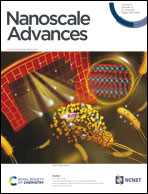Plasmon-induced ultrafast charge transfer in single-particulate Cu1.94S–ZnS nanoheterostructures†
Abstract
Recombination centers generated from structural and interfacial defects in nanoheterostructures (NHs) prevent effective photo-induced charge transfer and have blocked the advance of many photoresponsive applications. Strategies to construct high-quality interfaces in NHs are emerging but are limited in the release of interfacial strain and the integrality of the sublattice. Herein, we synthesize single-particulate Cu1.94S–ZnS NHs with a continuous sublattice using a nanoscale cation exchange reaction (CE). Under near-infrared (NIR) radiation (λ = 1500 nm), femtosecond open-aperture (OA) Z-scan measurements are applied to investigate the nonlinear optical features of samples and verify the existence of plasma-induced charge transfer in the Cu1.94S–ZnS NHs system. The resulting charge transfer time (τCT) of ∼0.091 picoseconds (ps) was confirmed by the femtosecond time-resolved pump–probe technique. Such an ultrafast charge transfer process has been rarely reported in semiconductor–semiconductor NHs. The results suggest that CE can be used as a promising tool to construct well-ordered interfacial structures, which are significant for the performance enhancement of NHs for photon utilization.



 Please wait while we load your content...
Please wait while we load your content...